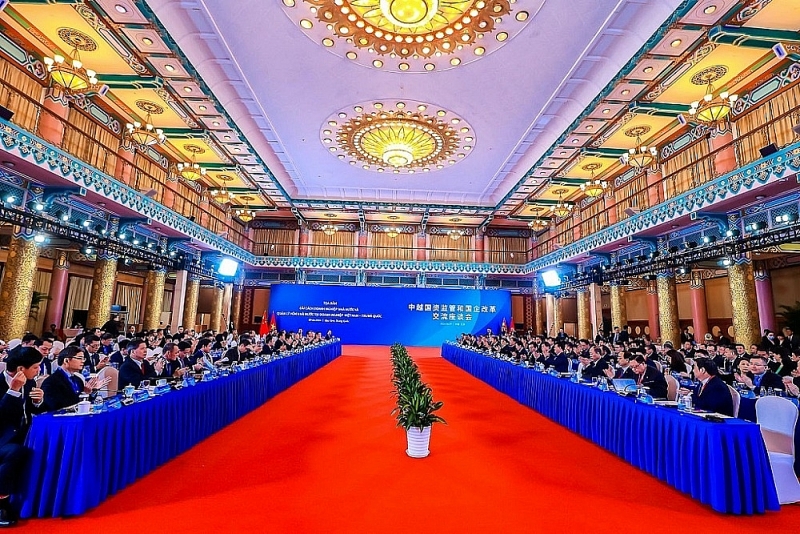 |
| Delegations of CMSC, SASAC and Vietnamese – Chinese businesses attended the seminar. |
In Vietnam, State-owned enterprises (SOEs) contribute approximately 30%, to GDP but their competitiveness is not commensurate with the inner resources and even many SOEs operate ineffectively.
According to the Committee for Management of State Capital at Enterprises (CMSC), by 2023, Vietnam will have 676 SOEs, including 478 enterprises with 100% charter capital held by the State. SOEs hold large resources in capital, assets, technology, high-quality human resources and significant contributions to the state budget; They also play a dominant and leading role in many important industries and sectors of the economy.
According to CMSC Chairman Nguyen Hoang Anh, in addition to the results achieved, in recent times, Vietnamese SOEs have still revealed some limitations in operational efficiency. Particularly, competitiveness is not commensurate with their own resources and they have not clearly demonstrated theri prominent role in leading, motivating, and promoting other economic sectors to develop.
Deputy Prime Minister Tran Luu Quang emphasized that Vietnam – China SOEs can strengthen investment cooperation in the fields of agriculture, infrastructure, energy conversion, digital economy, and green development. At the same time, both sides should share practical lessons on corporate governance and reform, supervision and management of state capital at enterprises; Promote cooperation in training human resources, especially senior management human resources of SOEs; Research and build a cooperation mechanism between SOEs and state-owned enterprises. Cooperate to build the connection “Two Corridors, One Belt” and “Belt and Road”. |
Speaking at the discussion session “SOE reform and state capital management in Vietnam – China enterprises” organized by CMSC in collaboration with the State Council Supervision and Asset Management Committee of the People’s Republic of China (SASAC) recently held in Beijing (China), CMSC Vice Chairman Do Huu Huy said that, facing the requirements of the new context, SOE reform in Vietnam in the coming period needs to be prioritized and focused more to promote its role as an important material force of the state economy, carry out a leading role, and actively participate in building and developing the country to contribute to the successful implementation of the Vietnam’s 10-year socio-economic Development Strategy 2021-2030.
Sharing experiences in innovating corporate governance and implementing equitization and divestment at enterprises, Mr. Nguyen Quoc Huy, General Director of State Capital Investment and Trading Corporation (SCIC) said, given state capital divestment in enterprises, to date, SCIC has sold capital in 1,054 enterprises (sold out: 950 enterprises, sold off: 104 enterprises, sold buying rights: 19 enterprises), earning 51,668 billion VND, 4.1 times the cost price. The divestment of state capital at SCIC’s enterprises has been implemented in accordance with the law, ensuring publicity, transparency, achieving high efficiency, preserving and developing state capital.
Regarding equitization, General Director of SCIC said that to date, SCIC has received 34 limited liability companies with 1 and 2 members and has completed arrangement, equitization and capital sale in 30 enterprises.
According to Mr. Nguyen Quoc Huy, before taking over, most of these businesses were small-scale, under financial risks and some even were still at risk of bankruptcy. After receiving, SCIC has developed and submitted to competent authorities for approval to organize the implementation of the Restructuring Project and handle financial problems to realize the capacity and arrangement of equitization.
The implementation of arrangement and equitization of one-member limited liability companies at SCIC has achieved good results, ensuring publicity and transparency requirements. The equitization process is carried out in accordance with the provisions of law and methods. The arrangement and equitization project has received high consensus from officials and employees of enterprises as well as local authorities,” SCIC General Director stated.
Similarly, according to Mr. Dang Sy Manh, Chairman of the Board of Members of Vietnam Railway Corporation (VNR), the Company is constantly innovating, improving quality and increasing amenities on trains to serve passengers. In particular, VNR has focused on increasing freight transport output, especially international intermodal goods. The target set for 2035 is that passenger transport is expected to grow at 6.8%/year, and cargo growth at 5.0%/year.
Along with their own efforts, SOEs believe that the socio-economic development perspectives of Vietnam and China have many similarities, so the two sides can deepen exchanges, share experiences, and promote promote cooperation in areas where both sides can be strong.
Agreeing with the opinion of the Vietnamese side, Mr. Truong Ngoc Trac, Chairman of SASAC, stated that SOEs are an important force in the country’s modernization process, so it is necessary to build leading, open, “rich” vitality” enterprises, which are the pillar supporting the national economy, capable of coping with crises. Mr. Truong Ngoc Trac affirmed the importance of promoting the role of a supervisory agency and managing state capital towards becoming increasingly professional; and the importance of operation and business methods in promoting the integration of SOEs.
Mr. Truong Ngoc Trac said that SASAC and CMSC have actively exchanged and discussed solutions to respond to the challenges being posed to promote the integration of SOEs. This will be a stepping stone to promote practical cooperation, create new steps, enhance in-depth understanding, and continue to develop relations.
The former is to continue building the Vietnam – China sharing community, serving the purpose of developing businesses of the two countries in the fields of infrastructure technology, energy, industry, trade… The latter is on the foundation of bilateral good and high-level common awareness of the two Parties and countries, both sides take advantage of opportunities and soon realize cooperative relations, jointly building the connection “Two Corridors, One Belt” and “Belt and Road”.
